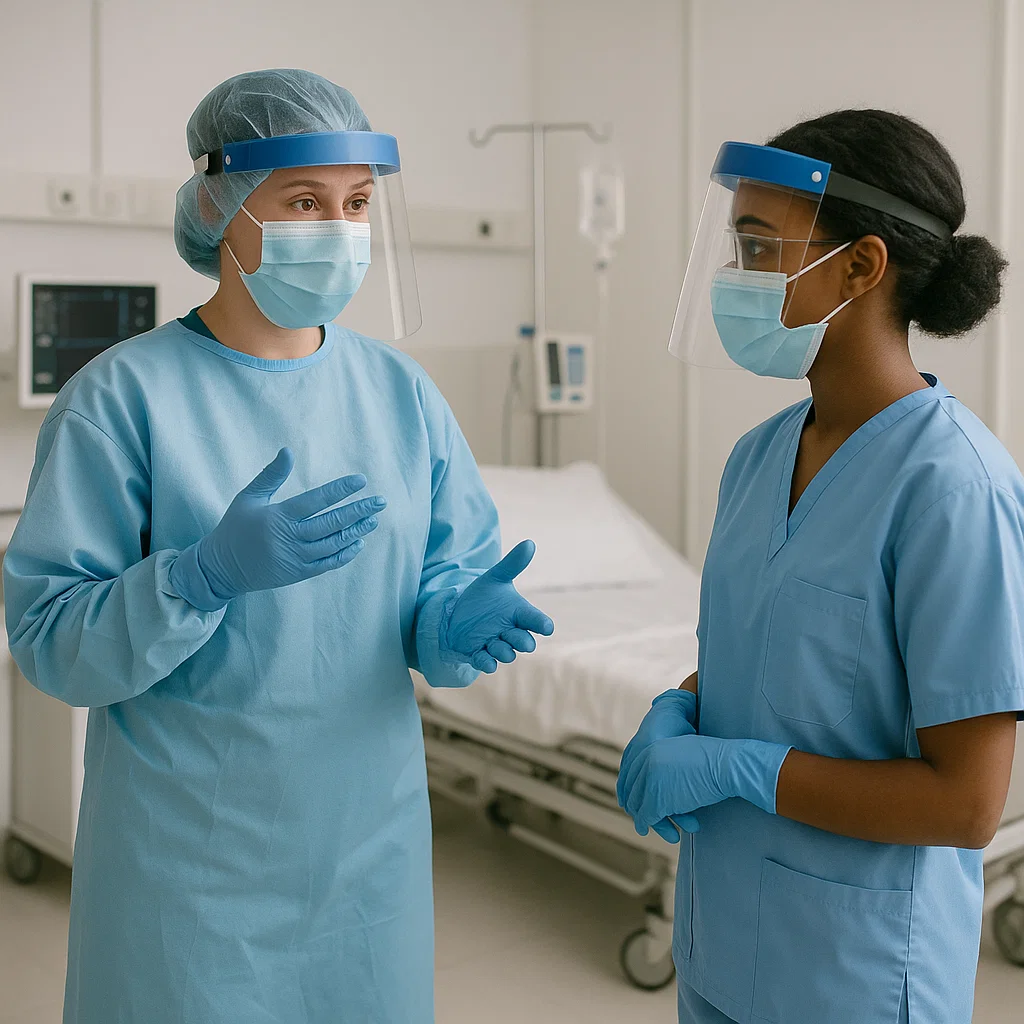Infection control is one of the most essential topics for nurses and a frequent question on the NCLEX. Understanding Standard Precautions and Transmission-Based Precautions helps every registered nurse (RN) prevent healthcare-associated infections and ensure patient and staff safety.
This simplified guide breaks down the types, PPE use, and real-world nursing applications you need to know.
🩺 What Are Standard Precautions?
Standard Precautions are the foundation of infection prevention. They assume that every patient may carry infectious agents, even if they show no symptoms.
Every nurse and nursing student must apply these precautions consistently across all settings.
🧼 Key Components of Standard Precautions:
- Hand hygiene: Before and after every patient contact.
- Personal Protective Equipment (PPE): Gloves, gowns, masks, and eye protection as needed.
- Respiratory hygiene: Covering coughs/sneezes and wearing masks when indicated.
- Safe injection practices: Using sterile needles, never recapping.
- Environmental cleaning: Proper disinfection of surfaces and equipment.
- Handling of sharps and linens: Use puncture-proof containers and avoid shaking linens.
💡 NCLEX Tip:
If a question doesn’t specify the type of infection, always apply Standard Precautions first.
🧫 What Are Transmission-Based Precautions?
When a patient is known or suspected to have a specific infectious disease, nurses must use Transmission-Based Precautions in addition to Standard Precautions. These are divided into three categories based on how the infection spreads.
🚪 1. Contact Precautions
Used for: MRSA, C. difficile, RSV, Scabies, and wound infections.
🧤 Nursing Actions:
- Wear gloves and gown upon room entry.
- Use dedicated equipment (stethoscope, BP cuff).
- Perform hand hygiene with soap and water (especially for C. diff).
- Private room preferred.
💡 NCLEX Tip:
For C. difficile, alcohol-based hand rubs are not enough — use soap and water.
🌬️ 2. Droplet Precautions
Used for: Influenza, pertussis, mumps, meningitis, rubella.
😷 Nursing Actions:
- Wear a surgical mask within 3 feet of the patient.
- Patient wears a mask when leaving the room.
- Private room or cohort with same infection.
💡 NCLEX Tip:
Remember the mnemonic “SPIDERMAN” for droplet diseases:
S—Sepsis, P—Pneumonia, I—Influenza, D—Diphtheria, E—Epiglottitis, R—Rubella, M—Meningitis, A—Adenovirus, N—Mumps.
🌪️ 3. Airborne Precautions
Used for: Tuberculosis, measles (rubeola), varicella (chickenpox), and shingles.
🧑⚕️ Nursing Actions:
- Wear an N95 respirator.
- Patient placed in a negative pressure room.
- Limit patient transport.
- Patient wears surgical mask during transport.
💡 NCLEX Tip:
The mnemonic “My Chicken Hez TB” helps you remember airborne diseases:
My—Measles, Chicken—Chickenpox, Hez—Herpes Zoster, TB—Tuberculosis.
📋 Comparison Table: Standard vs Transmission-Based Precautions
| Feature | Standard Precautions | Transmission-Based Precautions |
|---|---|---|
| Applied To | All patients | Patients with known or suspected infections |
| Goal | Prevent general infection | Prevent specific modes of transmission |
| PPE | As needed | Specific to transmission type (contact, droplet, airborne) |
| Room Type | Shared acceptable | Private or negative pressure for airborne |
| Examples | Blood, body fluids | TB, MRSA, Flu, C. diff |
👩⚕️ The Nurse’s Role in Infection Control
A registered nurse (RN) is the first line of defense against hospital-acquired infections.
Nurses must:
- Educate patients and families on infection prevention.
- Properly don and doff PPE.
- Monitor for signs of infection.
- Communicate isolation status to all staff.
💡 Tip for Nursing Students:
Infection control questions appear in almost every NCLEX exam. Memorizing the precaution categories and appropriate PPE is essential for success.
🧩 Why Study Infection Control Through a Nursing Bundle?
Using a nursing bundle for infection control simplifies memorization. Visual charts, mnemonics, and real-case scenarios help RN nurses retain the information faster and apply it confidently in clinical practice.
🩹 Final Thoughts
Infection control isn’t just policy — it’s life-saving practice.
Knowing the difference between Standard and Transmission-Based Precautions helps nurses protect themselves, their patients, and their colleagues.
Whether you’re preparing for the NCLEX or working as a registered nurse, this is one skill you’ll use every single day.
🩺 FAQ: Infection Control in Nursing
Standard precautions are the basic infection prevention practices used for all patient care, regardless of diagnosis — such as hand hygiene, gloves, and safe injection practices.
Transmission-based precautions are additional measures used for patients known or suspected to be infected with pathogens that spread by contact, droplet, or airborne routes.
Every registered nurse and RN nurse must understand both for the NCLEX and clinical practice.
Standard precautions should be applied at all times by every nurse when there’s a risk of exposure to blood, body fluids, non-intact skin, or mucous membranes.
These are essential infection control steps that all RN nurses follow to protect both patients and healthcare providers.
Contact precautions – for infections like MRSA or C. difficile.
Droplet precautions – for diseases like influenza or meningitis.
Airborne precautions – for tuberculosis or measles.
Hand hygiene is the most effective way to prevent the spread of infection.
Every registered nurse and RN nurse must perform hand hygiene before and after patient contact, and before performing sterile procedures.

